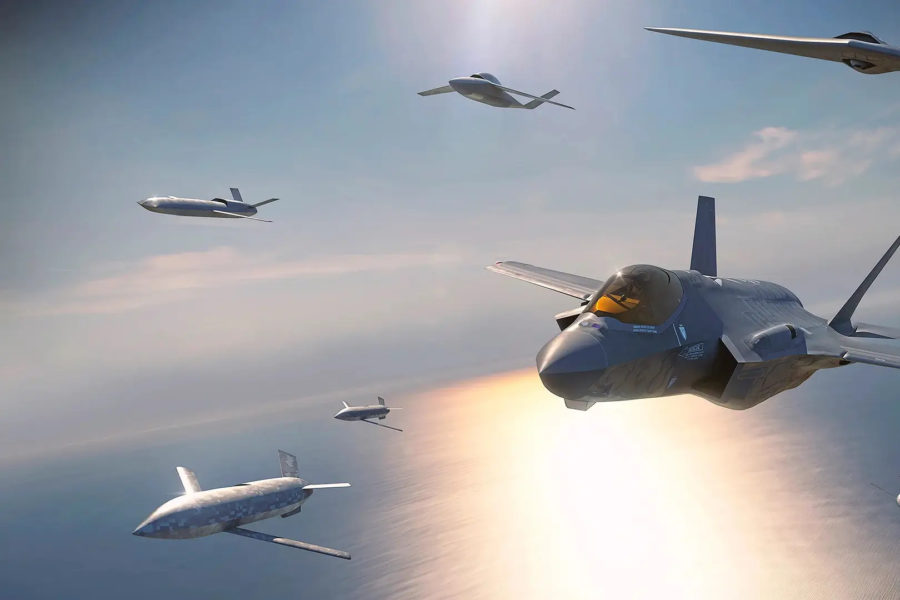In the face of Chinese war plans to disrupt U.S. command-and-control networks in the event of a conflict, the Air Force needs to focus less on its “connect everything” efforts and prepare its combat aviators to fight without a constant connection to higher-ups, according to a new report from AFA’s Mitchell Institute for Aerospace Studies.
The concept of “Disaggregated Collaborative Air Operations,” as proposed by report author retired Navy Commander J. Michael Dahm, is somewhat against the grain of most Pentagon thinking at the moment, as officials continue to push an ambitious Joint All-Domain Command and Control network that connects sensors and shooters around the globe.
“If your adversary is going to turn out the lights, you can either try to keep the lights, which may be a futile effort, or you can learn to fight in the dark,” Dahm told reporters at a briefing on the report.
In that analogy, China is the one trying to turn out the lights. Dahm, a longtime China observer, noted that the People’s Liberation Army has crafted its offensive and defensive strategies and capabilities to target and counter the U.S. military’s sprawling command, control, communications, computers, intelligence, surveillance, and reconnaissance network.
Rather than focus solely on not letting that happen, retired Air Force Col. Mark Gunzinger, also with the Mitchell Institute, argued Dahm’s DCAO concept will help the Air Force “judo throw the PLA’s warfighting strategy.”
Central to the concept are fifth- and soon-to-come sixth-generation combat aircraft—the powerful sensing and processing capabilities on those platforms allow them to penetrate contested airspace and act as the “quarterback” for small formations that could include fourth-gen aircraft or drones like Collaborative Combat Aircraft, Dahm proposed.
“The F-35 and the F-22 aren’t just ‘Fs,’ they’re not just fighters,” retired Lt. Gen. David A. Deptula, dean of the Mitchell Institute, said during an event rolling out the report. “They’re sensors, shooters, they’re ISR platforms.”
Retired Air Force Gen. Tod D. Wolters, former head of U.S. European Command and Supreme Allied Commander Europe, said he saw that firsthand when NATO forces employed the F-35 to deter Russian aggression.
“An F-35, what it contributes … is deep access with an ability to see the environment to a range that we haven’t seen in the past, and gather information that allows us to gain situational awareness on enemy movement at a pace and at a speed that was revolutionary.”
In Dahm’s concept, the advanced aircraft would lead small formations into contested airspace and go “comms dark” with the broader command-and-control network, while maintaining connections with each other through low-power, short-range directional datalinks. An air operations center could broadcast some key information into the battlespace, which the formations would receive but not reply to, limiting the adversary’s ability to track them.
From there, the formations could launch attacks and even send drones outside the short-range comms “bubble” with a specific task to achieve, Dahm suggested.
The idea would be to more or less continuously keep sending formations into the battlespace, instead of favoring “pulsed” operations with large amounts of forces concentrated at one time, as some Air Force officials have suggested.
Standoff forces would still be needed, Dahm added, as well as airborne ISR and battle management platforms to collect information and even assess the effects of the disaggregated formations’ strikes.
There are challenges to making DCAO work, Dahm acknowledged: managing the complex logistics, overcoming the entrenched culture of strategic control over tactical forces, and ensuring air base defense. But the concept is necessary because “we need to reduce our dependence on centralized C4ISR,” he said. “It is what China is going to attack, and they will attack it mercilessly if we get into a large-scale conflict with the People’s Republic of China.”


